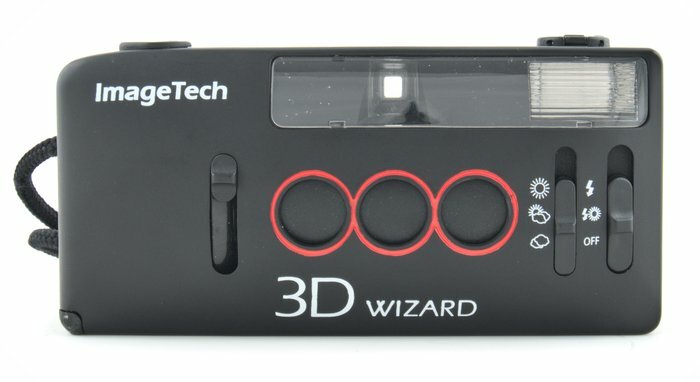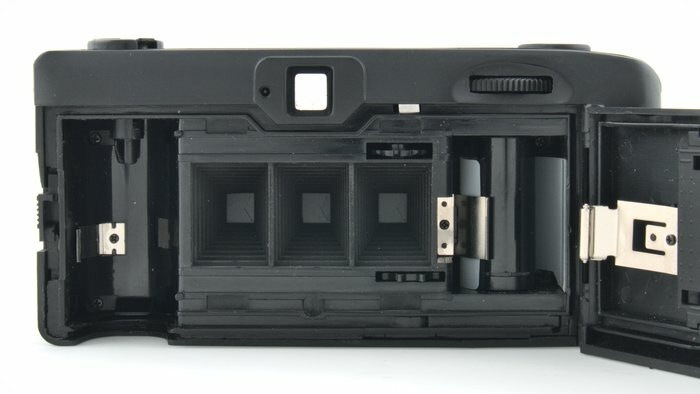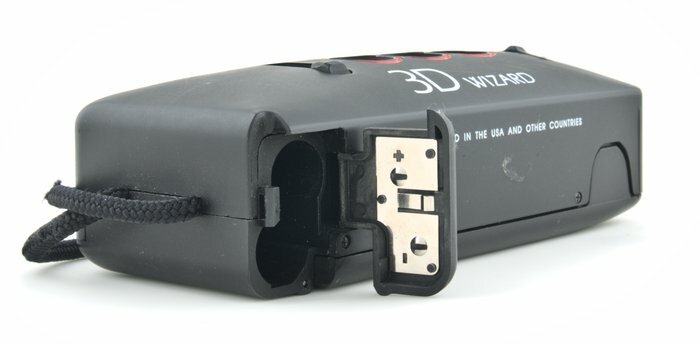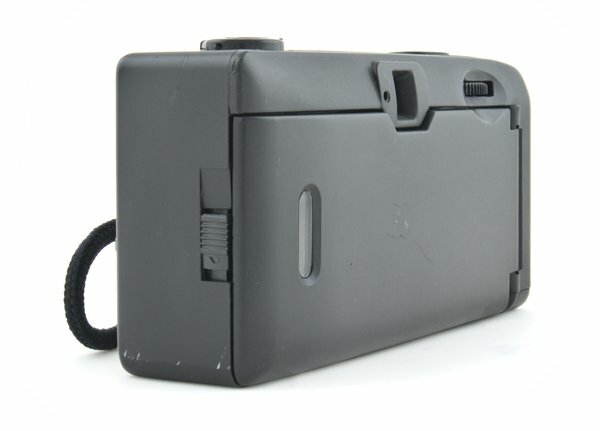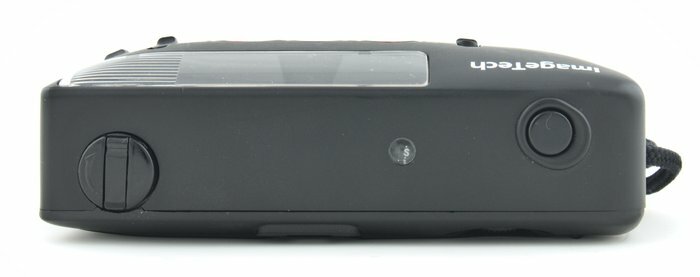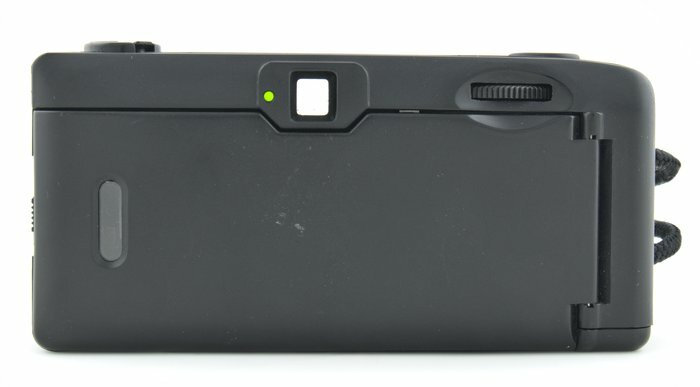ImageTech 3D Wizard 35mm Film 3D Camera
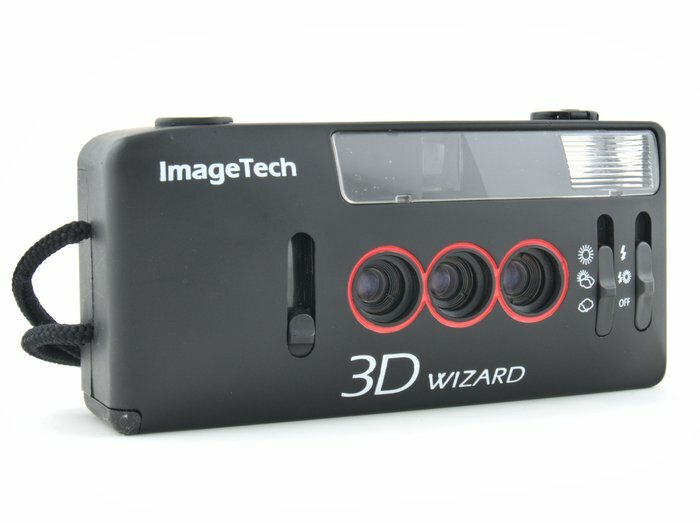
The ImageTech 3D Wizard was a novelty released to capitalize on making “3D” lenticular prints. These were popular in the 1980s and early 1990s.
Lenticular prints would have a 3-dimensional effect through the use of tiny plastic prisms. Slightly moving the print would give a “3D” effect without the need to wear 3D glasses or use a stereo viewer.
The build quality is what would be expected from a toy camera. Considering how expensive film is, I don’t see the point in using the camera. I would rather use a Nimslo 3D or Nishika N9000.
ImageTech vs Kalimar 3D Wizard
The ImageTech 3D Wizard is the Kalimar 3D Wizard with a different paint job.
ImageTech release a few other 3D lenticular stereo cameras. All of the cameras released had 3 lenses and used 35mm film.
The ImageTech 3D fx which is the same as the Kalimar 3D stereo camera. The only difference between the cameras is the paint scheme. I believe these cameras are the first generation of cameras as their build is nearly identical to the Wizards.
Another one was the ImageTech 3D1000. The final offering was a ImageTech 3D Magic 35mm single use film camera.
Finding a Camera
All of the ImageTech and Kalimar 3D cameras can be difficult to find. Some are occasionally available on Amazon, but the cameras tend to be easier to find on eBay.
Affiliate Advertising Disclosure
Outside the Shot is a participant in the Amazon Services LLC Associates Program, an affiliate advertising program designed to provide a means for sites to earn advertising fees by advertising and linking to Amazon.com.
As an eBay Partner, I may be compensated if you make a purchase. I also participate in affiliate advertising programs with KEH and Adorama. More can be found on the Affiliate Discolsure page.
Amazon
eBay
What Film for ImageTech 3D?
The 3 lenses in the camera will produce 3 images that use half of a standard 35mm film frame. This means that a roll of film with 36 exposures will only be able to take 24 sets of images with the ImageTech. A roll of film with 24 exposures would result in 18 sets of images.
While I am not positive, I am assuming the camera is meant to be used with ISO 400 35mm film. That’s because that is what the manual says to use with the ImageTech 3Dfx camera.
I would also guess that the shutter speed is a fixed 1/60 or 1/100 of a second. The aperture settings are likely f/8, f/11, and f/19 as that is what the Nishika N8000 uses.
There is a built-in flash that requires 2x AA batteries. There are two different settings for the flash. The switch is hard to operate and feels like something is sticking.
I tested the flash output with my Minolta Auto Meter VF and the power output of the flash did not change on either setting.
I then looked through the back of the lens while firing the camera shutter and the aperture appears to change shape to become larger. It is also possible that it might change the shutter speed of the camera.
Animated 3-Dimensional Gifs
An animated 3D gif can be created from digital film scans of the half-frame stereo images the camera captures. This can be done by layering pictures in a image editor such as GIMP or Adobe Photoshop.
The film images can be aligned by reducing the layer opacity and picking a point on the image subject to align all of the images to. The order of the layers should be film frame 1, 2, 3, and then back to 2. This order will allow the image to appear to loop forever.
Export the images to a gif and select a delay between frames of 150 to 200 milliseconds for the best results.
Stereoscopy & Creating Stereo Images with a 3D Camera
A fascinating use of 3D film cameras is the ability to create stereo images instead of 3D GIFs. This process utilizes the principle of stereoscopy by manipulating the set of images taken by the camera.
Typically, a 3D camera captures three images: left, center, and right. The standard practice for creating 3D GIFs would be to use all three of these images. However, to create stereo images, we can make use of just the outer two images - the leftmost and the rightmost.
By comparing and contrasting these two slightly different images, our brain can interpret the slight differences in perspective between them, resulting in the perception of a 3D image. This process mimics our natural binocular vision, where each eye perceives a slightly different viewpoint, and the brain fuses these together to form a sense of depth.
Printing Stereo Images and Using a Stereoscopic Viewer
Once these stereo images are created, they can be printed and viewed to experience the 3D effect. This typically involves a stereoscopic viewer – a device designed to present separate images to each eye, simulating binocular depth perception.
One classic example of a stereoscopic viewer is the View-Master. The View-Master is a special type of stereo viewer that utilizes circular discs, each containing seven pairs of small transparent color photographs on film. When a disc is inserted into the viewer, each eye sees a slightly different image, and our brain combines these to perceive a three-dimensional scene.
To use your stereo images with a View-Master, or similar device, you would need to print your two images onto positive film in the size and format compatible with the viewer. Once these are loaded onto a viewing disc and inserted into the device, you can then see your images with a vivid, lifelike depth that makes it feel as if you are truly present in the scene.
ImageTech 3D Wizard Review
The ImageTech 3D Wizard is a toy camera with cheap low quality lenses. I don’t think they are worth the $30-$50 the cameras are currently selling for.
The original selling point of the 3D camera was that you could have lenticular prints made. Now there is the trend of making animated 3D wobble gifs that introduce new photographers to stereo cameras.
While the effect can be fun, the camera isn’t enjoyable to use. The lack of any controls means your going to end up wasting a bunch of film in the process of occasionally getting a good image. The aperture on the lenses provides less than 2 stops of control over exposure.
Maybe you’re into Lomography, and that process is what you’re looking for. That expired film you have sitting around needs to get used in something.
Or you could pay more for a Nimslo 3D camera and actually get some control and 4 lenses. I don’t see the average photographer wanting to shoot more than a couple of rolls of film with any of the vintage 3D toy cameras out there.
Alternative 3D Film Cameras
The following cameras have either 3 or 4 lenses and take half frames on 35mm film.
